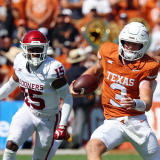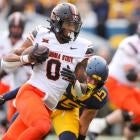
For a month, maybe longer, Kedon Slovis remembers driving around Los Angeles with his teammates looking for a place to practice. COVID-19 had shuttered his USC program. State and local health regulations had made most any swath of land off limits for even casual football workouts.
"There's a few times I got the guys together and started driving around L.A. trying to find parks or high schools that were still open," the Trojans quarterback said. "We got kicked off a few fields. It was pretty frustrating. It felt a lot longer than it was. There wasn't a whole lot to do. … There wasn't much of a place to do it."
This is a slice of life in the Pac-12 over the last few months. Basketball teams were practicing on tennis courts. Stanford football temporarily moved to a neighboring county to practice in order to avoid stricter local COVID-19 restrictions. Slovis and his teammates had their own issues.
"We kind of threw routes on air," he said. "We had to wash down the balls every time we were touching them. It was very different football experience."
Sure, COVID-19 has been painful for everyone. But out on the West Coast, the coronavirus' impact was worse.
When it comes to football, health regulations in Oregon and California in particular made it difficult for the Pac-12 to play a fall season at all. Half the conference's schools were located in those states.
The Pac-12 followed the Big Ten by canceling its season in August. That's where it stood for the Pac-12 until a Sept. 24 reconsideration to play a seven-game season beginning Saturday.
A letter from Trojans athletes -- crafted with the help of USC administrators -- has grown in significance as the league approaches this week's kickoff. The brainchild of a handful of USC players, including Slovis, the letter started with a simple idea: It indeed was possible to play football on the West Coast in the middle of the pandemic.
The Pac-12 should give thanks. Yes, it took governors, athletic directors, presidents and health professionals to make it happen. But someone, somewhere had to kick-start the effort. League commissioner Larry Scott had been talking about a late November start, at best, as late as mid-September.
"We were watching, I think, the first or second week of college football games kind of thinking what we can do," said Slovis, a sophomore from Scottsdale, Arizona. "We had the idea of actually talking to coach [Clay Helton]. There was, 'Let's wait and see what happens.' But enough guys already got to coach. He kind of mentioned it to us at practice. He said the best thing we can do is get the attention of the state officials who were regulating everything."
At that point in September, public gatherings were limited to 12 people. The Pac-12 had already announced on Sept. 3 it was going to daily testing. A "game changer," as Scott called it. Except it seemed the league hadn't moved much beyond that testing announcement to get back on the field ... until the letter, released on Sept. 15.
Dear @GavinNewsom ,
— Amon-Ra (@amonra_stbrown) September 15, 2020
Please let us play. We want a chance
Thank you #LetUsPlay pic.twitter.com/GV71WxCxfH
Helton was behind it. A leadership council of 8-10 players were in on it. Brandon Sosna, new AD Mike Bohn's chief of staff, essentially crafted the players' letter.
"We made a few small changes," Slovis said. "He did most of the heavy lifting."
The letter to California Gov. Gavin Newsom on Sept. 15 stated, "There are too many restrictions imposed by local public health officials." It pointed out the quick turnaround aspects of the league's daily testing.
The next day, Newsom told the media, "Nothing in the state guidelines denies the ability for the Pac-12 to resume." Except that was not the case. Newsom apparently wasn't aware football couldn't conduct a meaningful practice with gatherings limited to 12. A request for comment from Newsom's office was not answered.
"Part of me thought [the governor] was just deflecting," Slovis said. "But part of me thought maybe he's just never played football and just doesn't understand, which is totally valid, too."
Slovis told CBS Sports the correspondence definitely had an impact on the Pac-12 getting back on the field. Coincidentally or not, Newsom the next day discussed return-to-play options for the first time. That was 13 days after daily testing was announced and the same day (Sept. 16) that the Big Ten announced its return.
"The biggest impact, honestly, the letter had was the pressure publicly it [put on]," Slovis said.
Until then, there was a perception the Pac-12 dragged its feet after its ballyhooed testing announcement. On Sept. 4 -- 20 days before the Pac-12 announced its return -- Scott appeared on "The Dan Patrick Show". Asked specifically about playing football in the fall, Scott said, "[Basketball] is probably the first decision we've to make." He added that options to start football were "late November, early December" or January.
A week later, Scott reiterated on a Seattle radio station that "basketball will probably be upon us sooner" than football. Asked whether the Pac-12 could return sooner if the Big Ten started in October, he said, "It's hard to imagine things will fall in place that quickly."
Fine reporting by the San Jose Mercury News detailed email communications between league officials.
In a statement to CBS Sports, Scott said, "We are very pleased that we were able to find a path to bring back college football and our other sports following our innovative partnership with Quidel for daily rapid results antigen testing. We are equally pleased that our student-athletes have been active and engaged throughout our return to play discussions."
Behind the scenes, letter had the full support of Coach Clay Helton. It was printed on USC letterhead. This was different than Justin Fields posting a petition for #WeWantToPlay. This wasn't Trevor Lawrence becoming a social activist. This was desperation. The Pac-12 was about to become the only Power Five not playing in the fall.
"I was thinking if we want a shot at a playoff sport or a bowl, we can't play in the spring," Slovis said. "We have to get this off the ground as soon as possible."
This was also player empowerment, a grass-roots initiative by the kids. Slovis was 18 when he took over in the 2019 season opener for JT Daniels, who injured his knee. Daniels has transferred to Georgia and been cleared to practice, but he still hasn't seen the field. Slovis fit in perfectly completing 72% of his passes while throwing for 3,500 yards and 30 touchdowns.
Sosna, 28, is a similar rising star not only at USC but in all of athletics administration. At 23, he was Bohn's chief of staff at Cincinnati. In 2017-18, Sosna was the contract analyst for the Cleveland Browns. In 2020, Forbes named him to its "30 Under 30" list. If the Pac-12 pulls off this season, the story may well start in the McKay Center (football facility) and Heritage Hall (USC's athletics office).
If not for that combined effort, perhaps we're not having a discussion about the Pac-12's chances at the College Football Playoff. The conference's CFP history isn't good with two appearances in six years. Now the league will play seven straight weeks without a bye hoping to avoid the COVID-19 delays that have plagued most of the FBS conferences to this point.
But at least we're talking Pac-12 football. Arizona State and USC will play at 9 a.m. PT Saturday at The Coliseum in effort to get the league a bit more attention. Colorado, Washington State and Washington get new coaches. Be ready for Utah and Stanford, perhaps the two most physical teams in the league.
If not Oregon, then USC is the Pac-12's best playoff candidate. Those playoff chances could go one of two ways. An undefeated season means having to win only seven games. But how will the selection committee view the shortest schedule of any Power Five league?
"Right now, if we win all our games and look like one of the best teams in college football, it's going to be hard for them to say no," Slovis said. "That goes for any team in the Pac-12 not just us."
It's enough for now that the league can compete for bowls and remain on the same recruiting calendars as everyone else. All it took was a little ingenuity and sacrifice.
"It's probably a little unpopular with the guys because they have to wake up at 6:30 in the morning to get it done," Slovis said of the conference's daily testing. "I keep trying to remind them it's the only way we can play."
"I guess it matters how much you love football," he continued. "To me, football is everything to me. I'm willing to give up everything for college football."
















